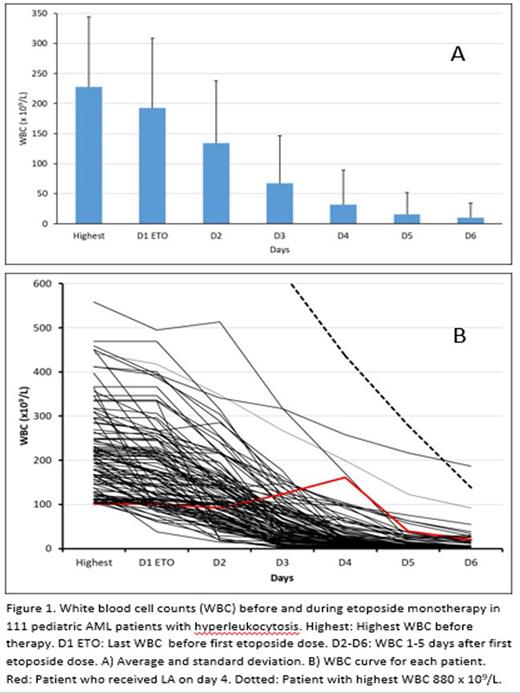Introduction: Hyperleukocytosis (HL) in pediatric acute myeloid leukemia (AML) is associated with severe complications and inferior outcome. Initial management is subject to debate, and the role of invasive methods such as leukapheresis (LA) and exchange transfusion (ET) has been questioned. We report the results on HL patients included in the NOPHO-DBH AML 2012 study.
Patients and methods: All patients were treated on the NOPHO-DBH AML 2012 protocol. Between January 1 st, 2013 and September 30 th, 2021, 714 patients were diagnosed, of whom 122 (17.1%) had HL, defined as white blood cell count (WBC) ≥100x10 9/L. Sixty-nine patients (9.7%) had WBC ≥200 x10 9/L. Protocol guidelines recommended immediate start of the first chemotherapy course (starting with etoposide [ETO] monotherapy for 5 days at 150 mg/m 2 once daily) followed randomized by either cytarabine/mitoxantrone (MEC) or cytarabine/daunoxome or daunorubicin (D[x]EC). The use of LA, ET, or prephase chemotherapy (PCT) was discouraged. In addition to registered data, we sent out questionnaires asking for additional detailed information on HL patients.
Results: HL patients had a median WBC of 211x10 9/L (range 101-880). They did not differ from Non-HL patients in terms of age, sex or CNS involvement, but had a higher proportion of extramedullary tumors (18% vs 11%). They had a significantly lower frequency of RUNX1::RUNX1T1 fusions (1.7% vs. 15.4%), and a higher proportion of KMT2A rearrangements (except KMT2A:: MLLT3) (23.1% vs. 12.2%), and FLT3-ITD without NPM1 mutation (20.7% vs. 8.1%).
Of the 122 HL patients, 111 (90.2%) were treated according to the guidelines with ETO upfront. LA was used in six patients (4.9%), in one case combined with ET. One of the LAs was performed in a patient unresponsive to ETO (increasing WBC after 2 days of ETO treatment). Eight patients received prephase chemo (various regimes) before start of the first course. In the 111 patients treated with ETO upfront, the first dose ETO was applied the same day as the AML diagnosis or the day after in 94.4%, and the drug was administered via peripheral veins in 37.8% of patients without major complications. After initiation of ETO, the remaining WBC on days 2-5 was 69.0%, 35.6%, 17.2% and 8.4% respectively, of the value before chemotherapy (Figure 1). On day 3, 80.9% had a WBC<100 x10 9/L.
Compared to the non-HL group, HL patients had a trend to higher early death rate within the first 6 weeks (5/122, 4.1% vs. 13/592, 2.2%, P=0.062), and a higher rate of resistant disease defined as > 5% blasts after 2 induction courses (14/122, 11.5% vs. 23/592, 3.9%, P=0.002). Five-year event-free survival (EFS) for all HL patients was 51.9±4.8 compared to 64.7±2.1 in the non-HL group. Overall survival (OS) was 73.5±4.2 and 78.7±1.8, respectively (log rank 0.089). Three children with HL died within 2 weeks from diagnosis (2.5%). Early death within 6 weeks occurred in 3/111 (2.7%) in the ETO-upfront group and 2/11 (18.2%) in the LA/ET/PCT group, P=0.064). Of 69 patients with WBC >200 x 10 9/L, 14 patients died, but only three during the first 6 weeks.
Conclusions: The NOPHO-DBH AML 2012 protocol is very effective in pediatric AML. The first chemotherapy course starts with five consecutive days of ETO monotherapy. We made use of this “ETO-window” in the management of HL patients, omitting invasive methods to reduce high WBCs. We conclude that in HL patients immediate ETO-therapy without LA/ET is feasible, easy to administer, safe and effective. Treatment results were excellent in terms of early death and OS. The significantly lower EFS for HL patients is explained mainly by a higher frequency of resistant disease, probably due to the higher proportion of high-risk AMLs (low rate of RUNX1:: RUNX1T1, high frequency of rearranged KMT2A and FLT3-ITD/NPM1wt). However, OS was not significantly lower for the HL group, which may be explained by successful salvage of patients with resistant disease or relapse using stem cell transplantation. WBC reduction during the first days of ETO therapy is comparable to reported results of LA, and outcome seems at least equivalent to studies using LA as part of their recommended therapy. Since the ETO-window allows avoiding invasive, costly and time-consuming procedures, the consortium now called NOPHO-DB-SHIP decided to stick to the same policy in the new protocol, CHIP-AML22.
Disclosures
Tierens:BD Biosciences: Honoraria, Speakers Bureau.


This feature is available to Subscribers Only
Sign In or Create an Account Close Modal